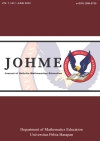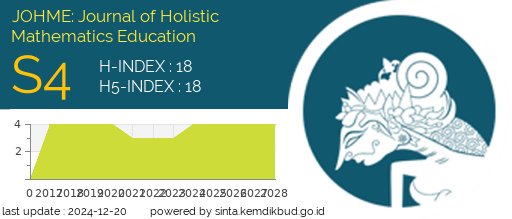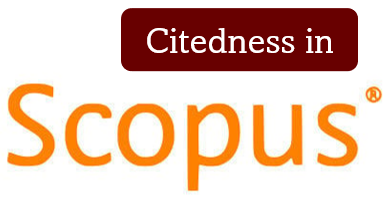ANALISIS BERPIKIR KRITIS MATEMATIS SISWA DALAM MENYELESAIKAN MASALAH KONTROVERSIAL [THE ANALYSIS OF STUDENTS’ MATHEMATICAL CRITICAL THINKING FOR SOLVING CONTROVERSIAL ISSUES]
DOI:
https://doi.org/10.19166/johme.v7i1.6523Λέξεις-κλειδιά:
critical thinking skills, mathematics controversial problem, kemampuan berpikir kritis, masalah kontroversial matematikaΠερίληψη
This research is a descriptive study using a qualitative approach with the aim of analyzing students' critical thinking skills in solving controversial mathematics problems using six indicators of IDEALS critical thinking. The research subjects in this study were 3 students of class X MIPA 1 SMA N 1 Singaraja who were obtained through a purposive sampling method. The research instruments this time were researchers, student worksheets, student test results, and interview results. Miles and Huberman's model is used in analyzing research data, through the process of data reduction, data presentation, and ending with drawing conclusions based on the data obtained. The results of the research and interviews show that students' critical thinking skills solve controversial mathematics problems with six indicators of IDEALS critical thinking, namely: (1) identify, it is found that the three subjects are able to identify the main problem and identify solutions to problems given that do not make sense, (2 ) define, it was found that the three subjects could define what was known and what was asked in the mathematical problem, but only by re-copying the questions, (3) enumerate, it was found that the three subjects only found one problem solving strategy that made sense, (4) analyze , each of the three subjects only used one problem-solving strategy for analysis, (5) list, it was found that the three subjects were able to state reasons for using the problem-solving strategy they used respectively, and (6) self-correct, it was obtained that the three subjects have re-checked the delivery strategy problem solutions that they use.
BAHASA INDONESIA ABSTRACT: Penelitian ini merupakan penelitian deskriptif menggunakan pendekatan kualitatif dengan tujuan menganalisis kemampuan berpikir kritis siswa dalam menyelesaikan masalah kontroversial matematika menggunakan enam indikator berpikir kritis IDEALS. Subjek penelitian dalam penelitian ini yaitu 3 orang siswa kelas X MIPA 1 SMA N 1 Singaraja yang didapatkan melalui metode purposive sampling. Dengan instrumen penelitian kali ini yaitu peneliti, lembar kerja siswa, hasil tes siswa, dan hasil wawancara. Model Miles dan Huberman digunakan dalam menganalisis data penelitian, melalui proses reduksi data, penyajian data, serta diakhiri dengan penarikan kesimpulan berdasarkan data yang diperoleh. Adapun hasil penelitian serta wawancara menunjukkan bahwa kemampuan berpikir kritis siswa menyelesaikan masalah kontroversial matematika dengan enam indikator berpikir kritis IDEALS, yaitu: (1) identify, diperoleh bahwa ketiga subjek mampu mengidentifikasi pokok permasalahan dan mengidentifikasi solusi dari masalah yang diberikan tidak masuk akal, (2) define, diperoleh bahwa ketiga subjek dapat mendefinisikan terkait yang diketahui serta apa yang ditanyakan pada persoalan matematika, tetapi hanya dengan menyalin ulang soal, (3) enumerate, diperoleh bahwa ketiga subjek hanya menemukan satu strategi penyelesaian masalah yang masuk akal, (4) analyze, masing-masing dari ketiga subjek hanya menggunakan satu strategi penyelesaian masalah tersebut untuk dianalisis, (5) list, diperoleh bahwa ketiga subjek mampu menyebutkan alasan menggunakan strategi penyelesaian masalah yang mereka gunakan masing-masing, dan (6) self-correct, diperoleh bahwa ketiga subjek sudah mengecek kembali strategi penyelesaian masalah yang masing-masing mereka gunakan.
Αναφορές
Abdullah, I. H. (2016). Berpikir kritis matematik. Delta-Pi: Jurnal Matematika dan Pendidikan Matematika, 2(1), 66-75. https://doi.org/10.33387/dpi.v2i1.100
Abdullah, K. (2017). Berbagai metodologi dalam penelitian pendidikan dan manajemen. Gowa, Indonesia: Gunadarma Ilmu.
Abdussamad, H. Z., & Sik, M. S. (2021). Metode penelitian kualitatif. Makassar, Indonesia: CV. Syakir Media Press.
Abidin, Z., & Tohir, M. (2019). Keterampilan berpikir tingkat tinggi dalam memecahkan deret aritmatika dua dimensi berdasarkan taksonomi Bloom. Alifmatika: Jurnal Pendidikan dan Pembelajaran Matematika, 1(1), 44-60. https://doi.org/10.35316/alifmatika.2019.v1i1.44-60
Abubakar, R. (2021). Pengantar metodologi penelitian. Yogyakarta, Indonesia: Suka Press
Aizikovitsh-Udi, E., & Cheng, D. (2015). Developing critical thinking skills from dispositions to abilities: Mathematics education from early childhood to high school. Creative Education, 6(4), 455-462. https://doi.org/10.4236/ce.2015.64045
Alifiani, A., & Hasana, S. N. (2019). Analisis proses berpikir kritis mahasiswa dalam mata kuliah persamaan diferensial dan scaffolding-nya. JPM: Jurnal Pendidikan Matematika, 6(1), 28-35. https://doi.org/10.33474/jpm.v6i1.3464
Farman, F., Anjelina, S., Putri, Q. T., Mardiah, N. A., & Sari, K. (2021). Pengembangan instrumen penilaian pembelajaran matematika berbasis ISpring Suite. AKSIOMA: Jurnal Program Studi Pendidikan Matematika, 10(4), 2040. https://doi.org/10.24127/ajpm.v10i4.4288
Belecina, R. R., & Ocampo, J. M. (2018). Effecting change on students’ critical thinking in problem solving. EDUCARE: International Journal for Educational Studies, 10(2), 109-118. Retrieved from https://journals.mindamas.com/index.php/educare/article/view/949/857
Farib, P. M., Ikhsan, M., & Subianto, M. (2019). Proses berpikir kritis matematis siswa sekolah menengah pertama melalui discovery learning. Jurnal Riset Pendidikan Matematika, 6(1), 99-117. http://dx.doi.org/10.21831/jrpm.v6i1.21396
Fatmawati, F., & Murtafiah, M. (2018). Deskripsi kemampuan pemecahan masalah peserta didik kelas XI SMA Negeri 1 Majene. Saintifik, 4(1), 63-73. https://doi.org/10.31605/saintifik.v4i1.145
Gunur, B., Ramda, A. H., & Makur, A. P. (2019). Pengaruh pendekatan problem based learning berbantuan masalah open-ended terhadap kemampuan berpikir kritis ditinjau dari sikap matematis siswa. JOHME: Journal of Holistic Mathematics Education, 3(1), 1-15. https://dx.doi.org/10.19166/johme.v3i1.1912
Hikmawati, A. N., Maulana, N., & Amalia, D. (2020). Beban Kerja Berhubungan dengan Stres Kerja Perawat. Jurnal Ilmiah Kesehatan Jiwa, 2(3), 95-102. http://www.jurnal.rs-amino.jatengprov.go.id/index.php/JIKJ/article/view/23
Indrawati, H. (2011). Meningkatkan keterampilan berpikir kritis mahasiswa melalui implementasi model controversial issues pada mata kuliah ekonomi sumberdaya manusia dan alam. Pekbis, 4(1), 63-70. Retrieved from https://pekbis.ejournal.unri.ac.id/index.php/JPEB/article/view/430/424
Jannah, A. (2021). Analisis kemampuan berfikir kritis siswa kelas V ditinjau dari gaya belajar di SDN Jatisari 02 Kec. Geger Kab. Madiun [Doctoral dissertation]. Ponorogo, Indonesia: IAIN Ponorogo. Retrieved from http://etheses.iainponorogo.ac.id/id/eprint/15801
Kaliky, S., & Juhaevah, F. (2018). Analisis kemampuan berpikir kritis siswa kelas X SMA dalam menyelesaikan masalah identitas trigonometri ditinjau dari gender. Matematika dan Pembelajaran, 6(2), 111-126. Retrieved from https://iainambon.ac.id/ojs/ojs-2/index.php/INT/article/download/663/487
Komalasari, K. (2010). Pembelajaran kontekstual konsep dan aplikasi. Bandung, Indonesia: Refika Aditama.
Lestari, F., Putri, A. D., & Wardani, A. K. (2019). Identifikasi kemampuan berpikir kritis siswa kelas VIII menggunakan soal pemecahan masalah. Jurnal Riset Pendidikan dan Inovasi Pembelajaran Matematika (JRPIPM), 2(2), 62-69. https://doi.org/10.26740/jrpipm.v2n2.p62-69
Mahmuzah, R. (2015). Peningkatan kemampuan berpikir kritis matematis siswa SMP melalui pendekatan problem posing. Jurnal Peluang, 4(1), 11-20. Retrieved from https://jurnal.usk.ac.id/peluang/article/view/5860
Maswar, M. (2019). Strategi pembelajaran matematika menyenangkan siswa (MMS) berbasis metode permainan mathemagic, teka-teki dan cerita matematis. Alifmatika: Jurnal Pendidikan dan Pembelajaran Matematika, 1(1), 28-43. https://doi.org/10.35316/alifmatika.2019.v1i1.28-43
Mueller, M., & Yankelewitz, D. (2014). Fallacious argumentation in student reasoning: Are there benefits?. European Journal of Science and Mathematics Education, 2(1), 27-38. Retrieved from https://eric.ed.gov/?id=EJ1107646
Munawwarah, M., Laili, N., & Tohir, M. (2020). Keterampilan berpikir kritis mahasiswa dalam memecahkan masalah matematika berdasarkan keterampilan abad 21. Alifmatika: Jurnal Pendidikan dan Pembelajaran Matematika, 2(1), 37-58. https://doi.org/10.35316/alifmatika.2020.v2i1.37-58
Nugroho, P. B., Nusantara, T., As' ari, A. R., & Hidayanto, E. (2018). Critical thinking disposition: Students skeptic in dealing with ill-logical mathematics problem. International Journal of Instruction, 11(3), 635-648. Retrieved from https://eric.ed.gov/?id=EJ1183418
Pertiwi, W. (2018). Analisis kemampuan berpikir kritis matematis peserta didik SMK pada materi matriks. Jurnal Pendidikan Tambusai, 2(2), 821-831. https://doi.org/10.31004/jptam.v2i4.29
Pinzon, A., Gómez, P., & Gonzalez, M. J. (2022). Mathematics teachers' feedback responses to students' errors and unexpected strategies. Australian Journal of Teacher Education, 47(3), 19-34. Retrieved from https://search.informit.org/doi/abs/10.3316/informit.598634433019767
Rahayuningsih, S., & Kristiawan, I. (2018). Kemampuan berpikir kritis siswa dalam menyelesaikan masalah matematika. Conference on Innovation and Application of Science and Technology (CIASTECH), 1(1), 245-253. https://doi.org/10.19184/kdma.v7i1.5471
Rahim, R., Gumelar, G. R., Chabibah, N., Ritonga, M. W., Musyadad, V. F., Komalasari, D., ... & Haris, A. (2021). Pendekatan pembelajaran guru. Medan, Indonesia: Yayasan Kita Menulis.
Rosyadi, A. A. P. (2021). Analisis berpikir kritis mahasiswa dalam menyelesaikan masalah kontroversial matematika. EDU-MAT: Jurnal Pendidikan Matematika, 9(1), 1-13. http://dx.doi.org/10.20527/edumat.v9i1.9988
Sidiq, U., Choiri, M., & Mujahidin, A. (2019). Metode penelitian kualitatif di bidang pendidikan. Ponorogo, Indonesia: CV. Nata Karya. Retrieved from http://repository.iainponorogo.ac.id/484/1/METODE%20PENELITIAN%20KUALITATIF%20DI%20BIDANG%20PENDIDIKAN.pdf
Simatupang, T., & Appulembang, O. (2022). Kemampuan berpikir kritis siswa kelas VIII pada pembelajaran matematika melalui model pembelajaran berbasis masalah. JOHME: Journal of Holistic Mathematics Education, 6(2), 138-156. https://dx.doi.org/10.19166/johme.v6i2.4726
Susanto, A., Qurrotaini, L., & Mulyandini, N. (2020). Peningkatan kemampuan berpikir kritis siswa pada mata pelajaran IPS melalui model controversial issue. Jurnal Holistika, 4(2), 71-76. https://doi.org/10.24853/holistika.4.2.71-76
Syafitri, E., Armanto, D., & Rahmadani, E. (2021). Aksiologi kemampuan berpikir kritis (Kajian tentang manfaat dari kemampuan berpikir kritis). Journal of Science and Social Research, 4(3), 320-325. https://doi.org/10.54314/jssr.v4i3.682
Syafruddin, I. S., & Pujiastuti, H. (2020). Analisis kemampuan berpikir kritis matematis: Studi kasus pada siswa MTs Negeri 4 Tangerang. Suska Journal of Mathematics Education, 6(2), 89-100. Retrieved from https://ejournal.uin-suska.ac.id/index.php/SJME/article/view/9436
Jumaisyaroh, T., Napitupulu, E. E., & Hasratuddin, H. (2015). Peningkatan kemampuan berpikir kritis matematis dan kemandirian belajar siswa SMP melalui pembelajaran berbasis masalah. Kreano, Jurnal Matematika Kreatif-Inovatif, 5(2), 157-169. https://doi.org/10.15294/kreano.v5i2.3325
Tanjung, M. (2019). Kemampuan berpikir kritis matematika. Retrieved from https://www.researchgate.net/profile/Mila-Tanjung/publication/333103058_KEMAMPUAN_BERPIKIR_KRITIS_MATEMATIKA/links/5cdb8e09458515712eac1ecc/KEMAMPUAN-BERPIKIR-KRITIS-MATEMATIKA.pdf
Teli, M. (2021). Konsep dasar berpikir kritis. Retrieved from http://repository.poltekeskupang.ac.id/2000/1/Materi%20Metodology%20Keperawatan.pdfΛήψεις
Επιπλέον Αρχεία
Δημοσιευμένα
Πώς να δημιουργήσετε Αναφορές
Τεύχος
Ενότητα
Άδεια
Authors who publish with this journal agree to the following terms:
1) Authors retain copyright and grant the journal right of first publication with the work simultaneously licensed under a Creative Commons Attribution License (CC-BY-SA 4.0) that allows others to share the work with an acknowledgement of the work's authorship and initial publication in this journal.
2) Authors are able to enter into separate, additional contractual arrangements for the non-exclusive distribution of the journal's published version of the work (e.g., post it to an institutional repository or publish it in a book), with an acknowledgement of its initial publication in this journal.
3) Authors are permitted and encouraged to post their work online (e.g., in institutional repositories or on their website). The final published PDF should be used and bibliographic details that credit the publication in this journal should be included.”










